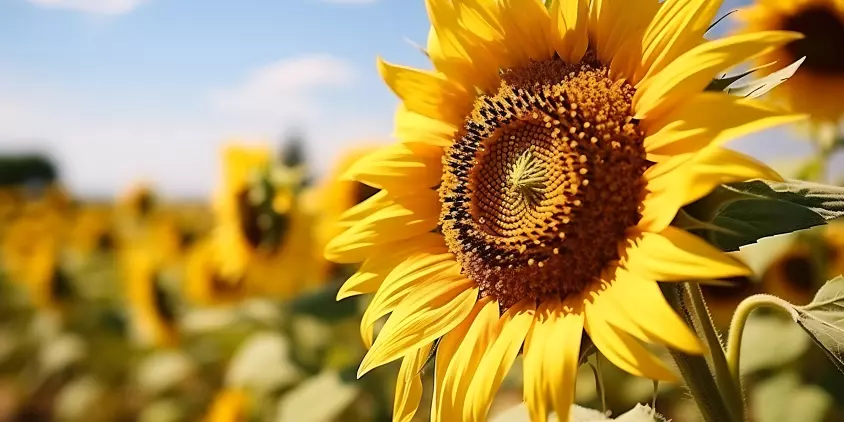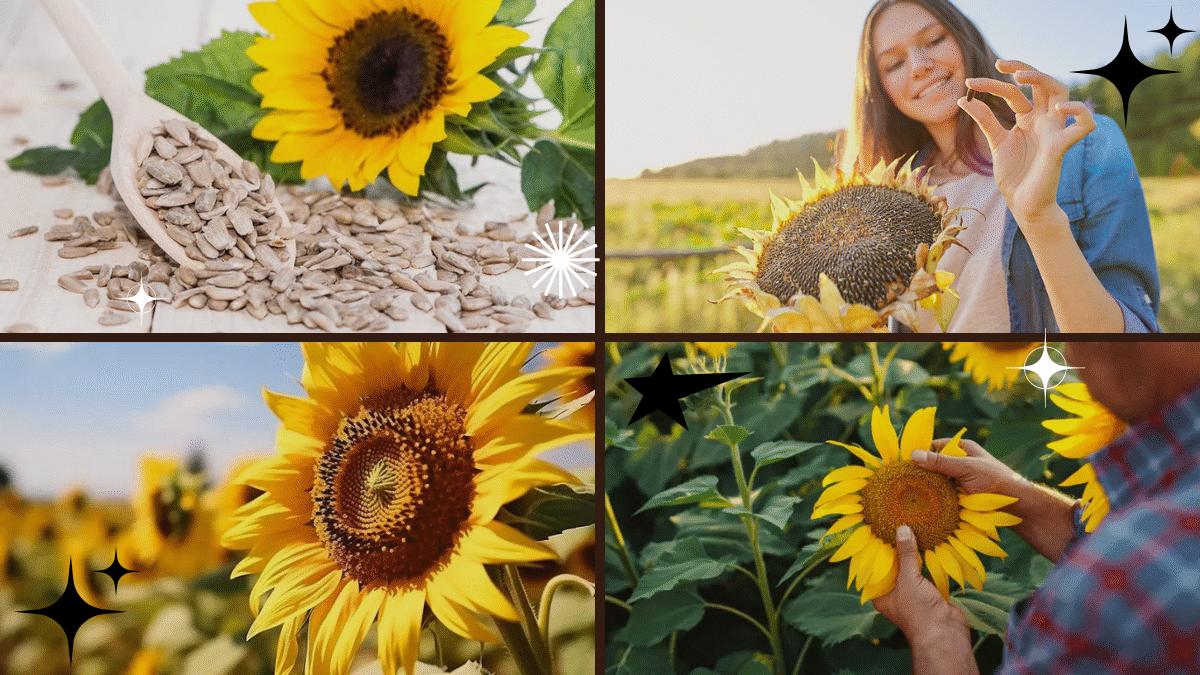Few plants capture the joy of summer quite like the cheerful, towering sunflower. With their bright yellow petals and impressive size, sunflowers are a favorite among both beginner and seasoned gardeners. Whether you want to grow them for their beauty, to attract pollinators, or for harvesting their nutrient-rich seeds, cultivating sunflowers from seeds is a simple, rewarding experience.
In this comprehensive guide, you’ll learn exactly how to grow a sunflower plant from seeds, from choosing the right variety to harvesting seeds at the end of the season.

Why Grow Sunflowers?
Before we dive into the how-to, let’s look at why sunflowers deserve a spot in your garden:
- Bright, eye-catching blooms that bring cheer to any space
- Attract beneficial pollinators like bees, butterflies, and birds
- Fast-growing and beginner-friendly — perfect for kids and first-time gardeners
- Edible seeds you can roast for snacks or leave for wildlife
- Natural privacy screen when grown in rows
Sunflowers thrive in a variety of climates and are hardy annuals, meaning they complete their life cycle in one season, making them a perfect plant to start from seed.
Step 1: Choose the Right Sunflower Variety
There are over 70 varieties of sunflowers, each differing in height, bloom size, and color. Selecting the right type will depend on your garden space and preferences.
Popular Sunflower Varieties:
- Mammoth Sunflower: Can reach 12–15 feet tall with giant 12-inch blooms — ideal for harvesting seeds.
- Teddy Bear Sunflower: Compact (2–3 feet tall) with fluffy, double-petaled blooms — great for containers or borders.
- Autumn Beauty: Multicolored petals in shades of yellow, orange, and red — grows 5–7 feet tall.
- Sunspot Sunflower: Dwarf variety (2 feet tall) with large, bright flowers — perfect for small gardens.
Tip: Mammoth varieties are best for edible seeds, while dwarf varieties work well in pots and tight spaces.

Step 2: Choose the Best Spot
Sunflowers are aptly named — they love the sun! The right location is crucial for healthy, vigorous growth.
Ideal Growing Conditions:
- Full sun: 6–8 hours of direct sunlight daily
- Well-draining soil: Avoid heavy clay or soggy soil
- Sheltered from strong winds: Especially for tall varieties
Since sunflowers can grow several feet tall, consider planting them at the back of garden beds or along fences.
Step 3: Prepare the Soil
Sunflowers aren’t overly fussy but thrive in fertile, loose soil with good drainage.
Soil Preparation Tips:
- Loosen soil to a depth of 12–18 inches to accommodate long taproots.
- Add organic matter like compost or well-rotted manure to improve fertility and texture.
- Test soil pH: Sunflowers prefer a neutral to slightly alkaline pH of 6.0–7.5.
If your soil is poor or compacted, consider growing sunflowers in raised beds or large containers.

Step 4: Plant the Seeds
Once the danger of frost has passed and soil temperatures reach about 50–60°F (10–15°C), you’re ready to plant.
Planting Steps:
- Dig holes 1–2 inches deep and space them 6 inches apart for small varieties, and 12–18 inches apart for large ones.
- Drop 1–2 seeds per hole.
- Cover lightly with soil and gently pat down.
- Water thoroughly after planting.
Tip: If planting multiple rows, leave about 2–3 feet between rows for ease of access and airflow.
Step 5: Care for Growing Seedlings
Sunflowers germinate quickly — usually within 7–10 days. During this time, keeping the soil consistently moist is important.
Watering:
- Water deeply once or twice a week once established.
- Avoid overwatering — sunflowers prefer slightly dry conditions between waterings.
- Focus water at the base to prevent fungal diseases.
Thinning Seedlings:
Once seedlings reach about 6 inches tall, thin them out to the strongest plant per spot, giving ample space for growth.

Step 6: Fertilizing (Optional but Helpful)
While sunflowers can grow in average soil, a little boost can enhance their size and bloom quality.
Fertilizing Tips:
- Use a balanced, slow-release fertilizer when plants are about a foot tall.
- Avoid high-nitrogen fertilizers — they promote foliage at the expense of flowers.
- For organic options, add compost tea or fish emulsion during the growing season.
Note: Over-fertilizing can cause tall plants to become leggy and prone to falling over.
Step 7: Provide Support for Tall Varieties
If growing Mammoth or other tall sunflowers, it’s wise to stake them to prevent bending or toppling.
- Use bamboo stakes, wooden poles, or tomato cages.
- Tie stems loosely with soft garden twine to avoid damaging the stalk.
Staking is especially important in windy areas or if soil is very loose.
Step 8: Watch for Pests and Problems
Sunflowers are generally hardy but can occasionally face issues.
Common Pests:
- Aphids: Small green insects that cluster on stems and buds. Remove with a strong spray of water or insecticidal soap.
- Caterpillars: Handpick or use organic Bacillus thuringiensis (Bt) treatments.
- Birds and squirrels: Cover seed heads with mesh or cheesecloth if you’re saving seeds.
Diseases:
- Powdery mildew: White powdery spots on leaves. Improve air circulation and avoid overhead watering.
- Rust and fungal spots: Remove affected leaves and water at the base.
Step 9: Harvesting
For Cut Flowers:
- Harvest blooms early in the morning when flowers just begin to open.
- Cut stems at a 45° angle and immediately place them in water.
For Seeds:
- Let the flower head turn brown and the back become dry and yellow.
- Cover heads with cheesecloth to protect from birds.
- Cut the head with about 12 inches of stem when fully dry.
- Rub seeds off by hand or with a stiff brush.
Tip: Roast seeds at 300°F (150°C) for 20–30 minutes for a tasty snack.
Step 10: End-of-Season Care
At the end of the growing season:
- Pull up dead plants and add them to your compost pile.
- Leave some heads in place to provide food for birds through fall.
- Save seeds from your best plants to sow next year.
Fun Facts About Sunflowers
- Sunflowers follow the sun — a phenomenon called heliotropism (young plants track the sun’s movement).
- The tallest sunflower on record reached over 30 feet tall!
- A single sunflower head can contain up to 2,000 seeds.
Final Thoughts
Growing sunflowers from seeds is a gratifying, beginner-friendly gardening project that delivers big, beautiful results. With minimal effort, you’ll have towering blooms brightening your yard and attracting beneficial pollinators. Whether you plant a few in a flowerbed, line a fence, or fill a pot with dwarf varieties, these sunny giants are sure to bring joy to your garden.
So grab a pack of seeds this season and get growing — your sun-drenched patch of yellow awaits!





Leave A Comment